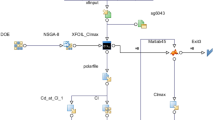Abstract
The authors of this paper have recently been involved in the development of a novel family of semielliptical hybrid Dolphin airfoils for general aviation applications. The previous work has shown noticeable improvements in aerodynamic characteristics of the modified hybrid Dolphin 2415 airfoil. In this paper, the same method has been applied to the airfoils of different thickness ratios. All numerical calculations were performed using RANS equations with the k−ω SST turbulence model. A comparison between a series of four-digit NACA 24xx, the original Dolphin, and the novel hybrid semielliptical Dolphin airfoils was made. Results have shown that in the range of thickness ratios above 15% and under 12%, the semielliptical hybrid Dolphin airfoils have shown a slight decrease in some aerodynamic characteristics compared to their NACA counterparts. This led to the conclusion that the semielliptical modification approach of the airfoil in its nose domain shows the best results within the 12–15% range of thicknesses, which is an important clue for further research of the hybrid Dolphin airfoils.
Access this chapter
Tax calculation will be finalised at checkout
Purchases are for personal use only
Similar content being viewed by others

Abbreviations
- s(x):
-
Skeleton line
- g(x):
-
Half-thickness distribution
- ze(x):
-
Suction surface
- zi(x):
-
Pressure surface
- α:
-
Angle of attack
- αcr:
-
Critical angle of attack
- v:
-
Freestream velocity
- CL:
-
Lift coefficient
- CD:
-
Drag coefficient
- CL/CD:
-
Lift-to-drag ratio
- CLMAX:
-
Maximum lift coefficient
- CDMIN:
-
Minimum drag coefficient
- xζ:
-
Position of the maximum camber
- xε:
-
Position of the maximum thickness
- ε:
-
Half-thickness of the airfoil
- ε1, ε2:
-
Half-thickness of the airfoil in points 1 and 2 (Fig. 2)
- M:
-
Mach number
- MRe:
-
Mega-Reynolds number, Re×106
References
Abbott, I. H. A., & von Doenhoff, A. D. (1949). Theory of wing sections; including a summary of airfoil data. McGraw-Hill.
Abbott, I. H., et al. (1945). Summary of airfoil data. Report NACA Report No. 824,. National Advisory Committee for Aeronautics.
ADIFO. (2015). All directional flying object, WO2017105266A1 - patent pending.
Chowdhury, S., Vani, D. R., Maldonado, V., Salazar, M., & Soujoudi, R. (2017). Experimental and computational investigation of passive surface flow control for aerodynamic efficiency. In 47th AIAA fluid dynamics conference. https://doi.org/10.2514/6.2017-4120
Dančuo, Z., Kostić, I., Kostić, O., Bengin, A., & Vorotović, G. (2022). Initial development of the hybrid semielliptical Dolphin airfoil. Thermal Science, 26(3 Part A), 2199–2210. https://doi.org/10.2298/TSCI210515234D
Fish, F., & Rohr, J. (1999). Review of dolphin hydrodynamics and swimming performance, Technical Report 1801, Spawar System Center San Diego.
Fish, F., & Rohr, J. (2004). Strouhal numbers and optimization of swimming by odontocete cetaceans. The Journal of Experimental Biology, 10(207), 1633–1642. https://doi.org/10.1242/jeb.00948
Floryan, D., Van Buren, T., & Smits, A. J. (2018). Efficient cruising for swimming and flying animals is dictated by fluid drag. Proceedings of the National Academy of Science of the United States of America, PNAS, 115(32), 8116–8118. https://doi.org/10.1073/pnas.1805941115
Huang, S., Hu, Y., & Wang, Y. (2020). Research on aerodynamic performance of a novel dolphin headshaped bionic airfoil. Energy. https://doi.org/10.1016/j.energy.2020.118179
Iouguina, A., Dawson, J. W., Hallgrimsson, B., & Smart, G. (2014). Biologically informed disciplines: A comparative analysis of bionics, biomimetics, biomimicry, and bio-inspiration among others. International Journal of Design & Nature and Ecodynamics (IJDNE), 9(3), 197–205.
Taposu, I. (2002). Profilele delfin. Un nou concept în aerodinamică (The dolphin profiles. A new concept in aerodynamics, in Romanian). S.C. Editura Technica S.A..
Vincent, J. F., Bogatyreva, O. A., Bogatyrev, N. R., Bowyer, A., & Pahl, A. K. (2006). Biomimetics: Its practice and theory. Journal of the Royal Society, Interface, 3(9), 471–482.
Author information
Authors and Affiliations
Corresponding author
Editor information
Editors and Affiliations
Rights and permissions
Copyright information
© 2024 The Author(s), under exclusive license to Springer Nature Switzerland AG
About this paper
Cite this paper
Dančuo, Z.Z., Kostić, I.A., Kostić, O.P., Bengin, A.Č., Vorotović, G.S. (2024). Influence of Thickness Ratio on the Aerodynamic Characteristics of a Family of Hybrid Semielliptical Dolphin Airfoils. In: Karakoc, T.H., et al. Novel Techniques in Maintenance, Repair, and Overhaul. ISATECH 2022. Sustainable Aviation. Springer, Cham. https://doi.org/10.1007/978-3-031-42041-2_1
Download citation
DOI: https://doi.org/10.1007/978-3-031-42041-2_1
Published:
Publisher Name: Springer, Cham
Print ISBN: 978-3-031-42040-5
Online ISBN: 978-3-031-42041-2
eBook Packages: EnergyEnergy (R0)



